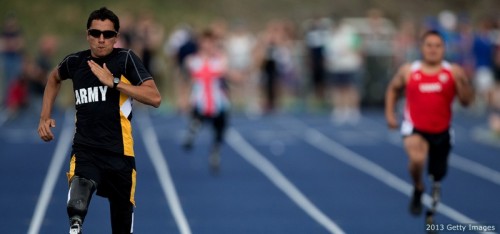VA program fuels elite athletic careers for veterans and injured service members

va program fuels elite athletic careers for veterans and injured service members
uis Puertas will fly to France soon as part of the U.S. team that will compete in the International Paralympic Committee Athletics World Championships in Lyon.
It’s a journey that likely never would have happened if Puertas hadn’t been watching the London 2012 Paralympic Games on his computer at home in Orlando, Fla., last summer.
On that day, Puertas saw Great Britain’s Richard Whitehead sprint to a world record and a gold medal in the 200 meters (T42 class).
Puertas, a former specialist with the U.S. Army’s 4th Infantry Division, already was living an active life — running 10Ks, marathons and swimming — after having lost both his legs above the knees in an explosion that tore apart his Humvee in Iraq in 2006. With the use of prostheses, Puertas was running again less than a year after his surgeries.
But when Puertas saw Whitehead rocket to a victory on new “running knees,” he knew he’d just seen his future. Whitehead, who also ran as a double above-the-knee amputee because of a congenital condition, “motivated me,” Puertas says.
“I want to be that guy,” Puertas said. “I want the crowd roaring for me.”
He wanted to be able to move the way Whitehead could move. So, Puertas picked up his phone.
“I was so excited, I immediately got on the phone with the Department of Defense and I told the people I wanted those knees so I could run, see how it works,” he recalled.
Almost nine months since beginning a new phase of serious training for 100- and 200-meter races, Puertas — who also is considering taking up the paratriathlon next year — is one of 10 military veterans (and two active-duty service members) on the 76-member U.S. track and field team that will compete in Lyon on July 19-28. He’ll be running the 200 meters in France.
The competition in Lyon comes almost a year after the London Games, in which 20 members of the U.S. Paralympic Team were either active-duty service members or military veterans.
More and more, veterans are becoming a key component of the U.S. Paralympic movement, and a partnership between the United States Olympic Committee and the Veterans Affairs’ Paralympic Program is helping these men and women excel.
The VA’s Paralympic Program helps in two ways. First, it provides $7.5 million to the USOC each year to aid in grassroots programs to help injured veterans and active-duty service members participate in adaptive sports and recreation. Second, it provides monthly stipends to qualified athletes to help defray costs for training, equipment, coaching, travel and competition.
Depending on their number of dependents and other factors, those athletes receive monthly checks that range from $566 to $1,070.
Puertas just recently hit the qualifying standards that allowed him to apply for those monthly benefits. He should start receiving them shortly and is looking forward to it.
“That allowance is great,” he said, after returning from England, where he participated in the IPC Grand Prix Finals June 29. “Because the amount of food you have to eat, and going to training every day, gas … the program is really set up (well). It’s out there so you don’t have any excuses of not going out there and doing it.”
Chris Nowak, the VA’s national director for veterans sports programs and special events, said the program is now in its fourth year. Numbers of participants among the elite athletes who have hit the standards to qualify for the monthly stipends continue to rise. Currently, says Nowak, more than 100 athletes have qualified.
“The USOC has established military standards (times, distances, performances) for veterans and members of the armed forces to meet, and once they meet those standards, and prove that they’re continually training, then they’re eligible for the allowance,” he said.
Jose Nieves, 54, a U.S. Army veteran, also will be on the U.S. team competing in France this month. He’s been a part of the VA’s elite-athlete support program since 2011 and said the monthly checks have helped greatly in his training.
He is ranked No. 2 in the world by the IPC in javelin (F55 class) and No. 4 in the discus.
“I’ve been able to get much better training, better techniques, more and better competition,” said Nieves, who lives in Puerto Rico.
For Nowak, who’s now in the 20th year with the VA, being a part of the program to help veterans and injured active-duty service members is incredibly gratifying.
In his capacity as national director of these sports programs, he’s had a chance to speak with the Paralympic athletes in London last year as well as athletes at the USOC’s Colorado Springs headquarters. It’s equally important to see veterans just regaining an active life as it is to see them win a medal in London.
“It’s just amazing,” he said. “And very rewarding.”
But the effort to help give veterans these opportunities is a team effort.
“I can’t emphasize enough how important the partnership is with the U.S. Olympic Committee,” Nowak said. “We couldn’t do this without their expertise and their leadership. We’re very fortunate to be working with an organization that cares so much about our nation’s veterans.”
In Puertas’ experience, the kindness and help he’s experienced since coming back from Iraq and embarking on what is now a very athletic life stretches much further.
“We get so much help,” said Puertas, who won the 100-, 200- and 1,500-meter races at this year’s Warrior Games presented by Deloitte in Colorado Springs, Colo. “Besides the VA, there are so many generous people out there. High schools, corporations want to help you. There’s just a lot of ways for us to go about our (athletic) careers.”

